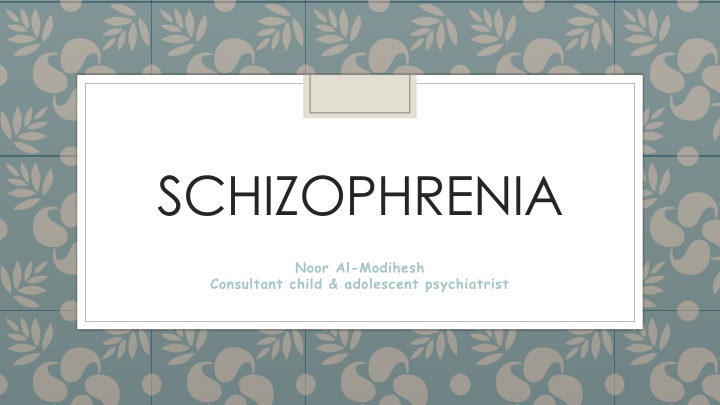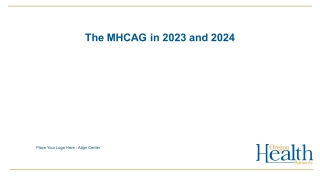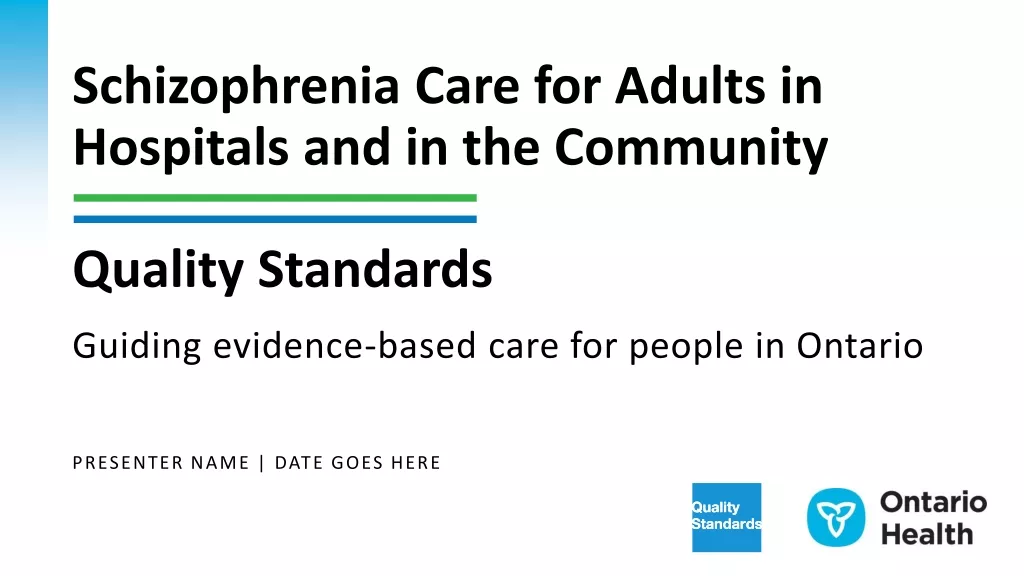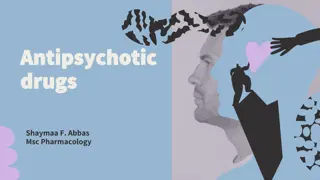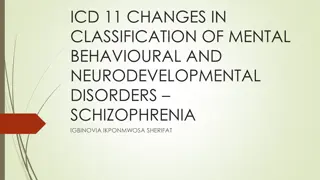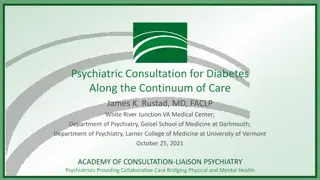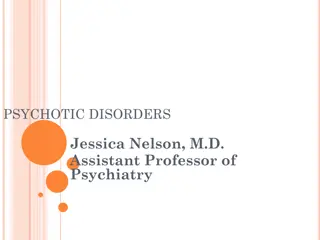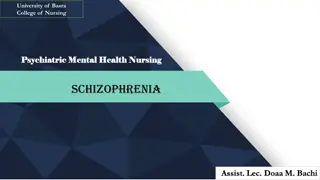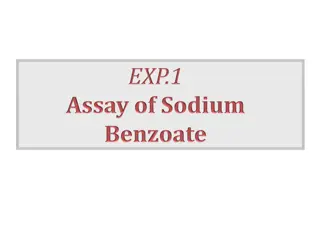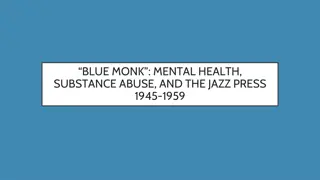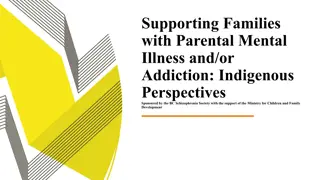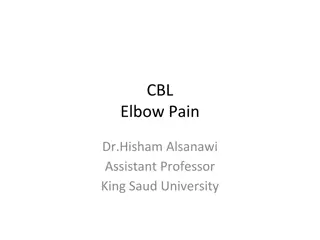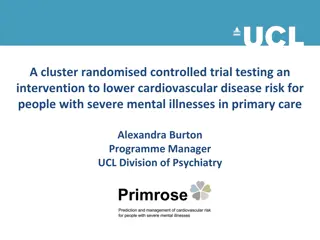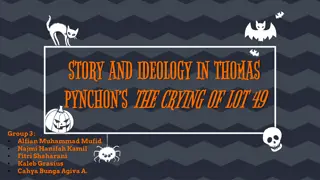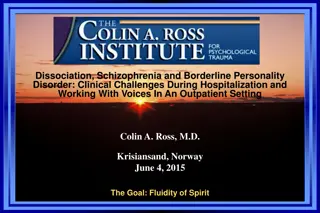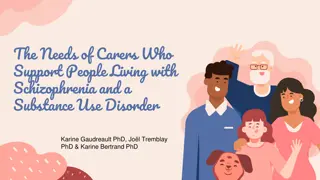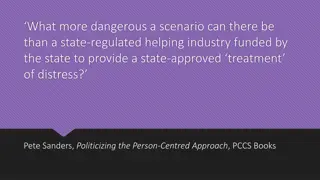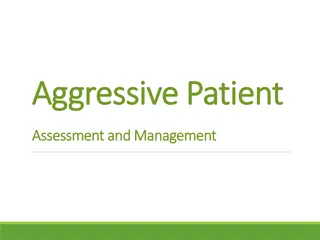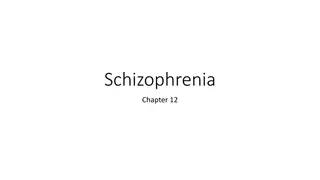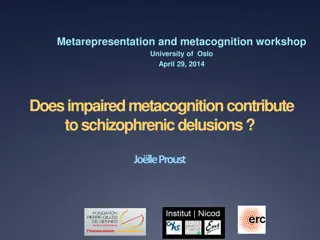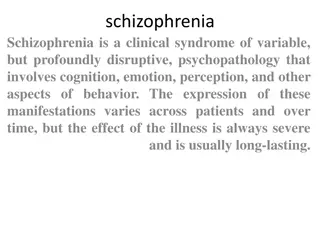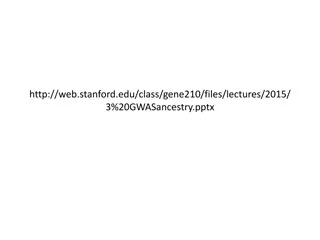SCHIZOPHRENIA
Schizophrenia and psychotic disorders are mental illnesses characterized by impairment in reality testing and personal functioning. Symptoms include hallucinations, delusions, negative symptoms, and deteriorated relationships. The DSM-5 categorizes various disorders within the schizophrenia spectrum. Epidemiologically, schizophrenia has a worldwide prevalence of 0.5-1%, typically emerging in early adulthood with a risk of suicide attempts. Clinical features encompass psychotic symptoms, negative dimensions like lack of motivation, and disorganized behaviors.
Download Presentation

Please find below an Image/Link to download the presentation.
The content on the website is provided AS IS for your information and personal use only. It may not be sold, licensed, or shared on other websites without obtaining consent from the author.If you encounter any issues during the download, it is possible that the publisher has removed the file from their server.
You are allowed to download the files provided on this website for personal or commercial use, subject to the condition that they are used lawfully. All files are the property of their respective owners.
The content on the website is provided AS IS for your information and personal use only. It may not be sold, licensed, or shared on other websites without obtaining consent from the author.
E N D
Presentation Transcript
SCHIZOPHRENIA Noor Al-Modihesh Consultant child & adolescent psychiatrist
Psychotic Disorders are mental illnesses characterized by gross impairment in reality testing and personal functioning Its symptoms include dysfunctions in nearly every capacity of which the human brain is capable perception, inferential thinking, language, memory, and executive functions. It is not split personality The illness is called schizo (fragmented or split apart) phrenia (mind) In DSM-V : psychotic spectrum
schizophrenia is defined by a group of characteristic symptoms, such as hallucinations, delusions, or negative symptoms (i.e., affective flattening, alogia, avolition); deterioration in social, occupational, or interpersonal relationships; and continuous signs of the disturbance for at least 6 months.
TABLE 51. DSM-5 schizophrenia spectrum and other psychotic disorders: Schizotypal personality disorder Delusional disorder Brief psychotic disorder Schizophreniform disorder Schizophrenia Schizoaffective disorder Substance/medication-induced psychotic disorder Psychotic disorder due to another medical condition Catatonia associated with another mental disorder (catatonia specifier) Catatonic disorder due to another medical condition Unspecified catatonia Other specified schizophrenia spectrum and other psychotic disorder Unspecified schizophrenia spectrum and other psychotic disorder
Epidemiology : worldwide prevalence of schizophrenia is about 0.5% 1%. age at first psychotic episode is typically 18 25 years for men and 21 30 years for women About one-third attempt suicide Annual incidence of 0.5 5.0 per 10,000
Clinical features : Psychotic symptoms : delusion & hallucinations Negative dimension : the absence of something that should be present, such as volition [lack of motivation]). Diminished emotional expression (affective flattening or blunting) Alogia is characterized by a diminution in the amount of spontaneous speech Anhedonia is the inability to experience pleasure Social withdrawal The disorganized dimension : includes disorganized speech and behavior and inappropriate affect.
Cognitive deficits : Attention , memory , verbal fluency Mood symptoms : Depression , anxiety , suicidal behavior, hostility , aggression
Other Symptoms lack insight; they do not believe they are ill and reject the idea that they need treatment. Non localizing neurological soft signs such as abnormalities in stereognosis, balance In active sex drive Substance abuse is common and includes alcohol and other drugs It is thought that many schizophrenic patients abuse substances in an attempt to lift their mood, boost their level of motivation, or reduce their medication side effects
Etiology : The exact etiology is UN KNOWON 1. Genetics : A wide range of genetic studies strongly suggest a genetic component to the inheritance of schizophrenia that outweights the environmental influence. These include: family studies, twin studies and chromosomal studies.
siblings of schizophrenic patients have about a 10% chance of developing schizophrenia. children who have one parent with schizophrenia have a 5% 6% chance. 17% for persons with one sibling and one parent with schizophrenia 46% for the children of two schizophrenic parents monozygotic twins an average of 46%, compared with 14% concordance in dizygotic twins
2. Neuroimaging and Neuropathology Cerebral ventricular enlargement Sulcal enlargement and cerebellar atrophy decreased thalamus size abnormalities have been reported in the brain particularly in the limbic system, basal ganglia and cerebellum. Either in structures or connections 3. Neurobiology Certain areas of the brain are involved in the pathophysiology of schizophrenia: the limbic system, the frontal cortex, cerebellum, and the basal ganglia. a- Dopamine Hypothesis; Too much dopaminergic activity ( whether it is release of dopamine, dopamine receptors, hypersensitivity of dopamine receptors to dopamine, or combinations is not known ). b- Other Neurotransmitters; Serotonin, Norepinephrine, GABA, Glutamate(hypofunction in NMDA receptors) & Neuropeptides
c. Psychoneuroimmunology; T-cell interlukeukin-2 & lymphocytes, abnormal cellular and humoral reactivity to neurons and presence of antibrain antibodies. These changes are due to neurotoxic virus ? or endogenous autoimmune disorder ? d. Psychoneuroendocrinology; Abnormal dexamethasone-suppression test LH/FSH A blunted release of prolactin and growth hormone on stimulation.
4- Psychosocial Factors: In family dynamics studies, no well-controlled evidence indicates specific family pattern plays a causative role in the development of schizophrenia. High Expressed Emotion family : increase risk of relapse. 5- Stress-Diathesis Model: Integrates biological, psychosocial and environmental factors in the etiology of schizophrenia. Symptoms of schizophrenia develop when a person has a specific vulnerability that is acted on by a stressful influence.
Diagnosis : DSM-5 Diagnostic Criteria for Schizophrenia: A- two characteristic symptoms for one month, at least one of them is (1),(2) or (3) 1- Delusions 2- Hallucinations 3- Disorganized speech (frequent derailment or incoherence) 4- Grossly disorganized or catatonic behavior 5- Negative symptoms ( diminished emotional expression or lack of drive (avolition))
B- Social, Occupation or self-care dysfunction C- Duration of at least 6 months of disturbance (include at least one month of active symptoms that meet Criterion A; in addition of periods of prodromal and residual symptoms). D- Schizoaffective & mood disorder exclusion E- The disturbance is not due to Substance or another medical condition. F- If there is history of autism spectrum disorder or a communication disorder of childhood onset, schizophrenia diagnosis is made only if delusion or hallucinations plus other criteria are present.
Mental Status Examination (MSE) : - Appearance & behavior ( variable presentations) - Mood, feelings & affect ( reduced emotional responsiveness, inappropriate emotion) - Perceptual disturbances ( hallucinations, illusions ) - Thought: Thought content ( delusions) Form of thought ( looseness of association) Thought process ( thought blocking, poverty of thought content, poor abstraction, perseveration ) - Impulsiveness, violence, suicide & homicide - Cognitive functioning - Poor insight and judgment
clinical course : Acute exacerbation with increased residual impairment Full recovery: very rare Longitudinal course: downhill
Differential diagnosis : Primary Psychiatric disorders: Schizophreniform disorder Brief psychotic disorder Delusional disorder Schizoaffective disorder Mood disorders Personality disorders ( schizoid, schizotypal & borderline personality) Factitious disorder Malingering Secondary psychiatric disorders: -Substance-induced disorders -Psychotic disorders due to another medical disorder : Epilepsy ( complex partial) CNS diseases Trauma Others
Other psychotic disorders : Psychotic Disorders due to another medical condition Substance-induced psychotic disorder Schizophreniform disorder ; 1-6 month of disturbance Brief psychotic disorder: <1month of disturbance Delusional disorder(delusion only >1m) Schizoaffective disorder: An uninterrupted period of illness during which there is a major mood episode (major depressive or manic) concurrent with Criterion A of schizophrenia. There is Delusions or hallucinations for 2 or more weeks in the absence of a major mood episode during the illness course.
Treatment : Reasons to hospitalize patients with schizophrenia 1. When the illness is new, to rule out alternative diagnoses and to stabilize the dosage of antipsychotic medication 2. For special medical procedures such as electroconvulsive therapy 3. When aggressive or assaultive behavior presents a danger to the patient or others 4. When the patient becomes suicidal 5. When the patient is unable to properly care for himself or herself (e.g.,refuses to eat or take fluids) 6. When medication side effects become disabling or potentially life threatening (e.g, neuroleptic malignant syndrome)
Biological Therapy : Antipsychotic medications are the mainstay of the treatment of schizophrenia. Generally, they are remarkably safe. Two major classes: -Conventional, (1st generation) e.g. haloperidol, chlorpromazine. -Atypical, 2nd generation (Serotonin-dopamine receptor antagonists) e.g. Risperidone, clozapine, olanzapine ). Depot forms of antipsychotics eg. Risperidone Consta is indicated for poorly compliant patients. Electroconvulsive therapy (ECT) for catatonic or poorly responding patients to medications
Psychosocial Interventions Assertive community treatment (ACT) programs : careful monitoring of patients through mobile mental health teams Family therapy, Cognitive rehabilitation involves the remediation of abnormal thought processes known to occur in schizophrenia, using methods pioneered in the treatment of brain-injured persons. Social skills training (SST) aims to help patients develop more appropriate behavior Psychosocial rehabilitation serves to integrate the patient back into his or her community rather than segregating the patient in separate facilities Vocational rehabilitation may help a patient obtain supported employment, competitive work in integrated settings, and more formal job training programs
